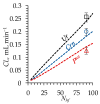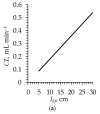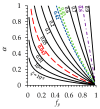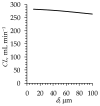Accounting for the Structure-Property Relationship of Hollow-Fiber Membranes in Modeling Hemodialyzer Clearance
- PMID: 39771343
- PMCID: PMC11728457
- DOI: 10.3390/polym16243491
Accounting for the Structure-Property Relationship of Hollow-Fiber Membranes in Modeling Hemodialyzer Clearance
Abstract
The relevance of the hemodialysis procedure is increasing worldwide due to the growing number of patients suffering from chronic kidney disease. Taking into account the structure of dialysis polymer membranes is an important aspect in their development to achieve the required performance of hemodialyzers. We propose a new mathematical model of mass transfer that allows hollow-fiber membrane structural parameters to be taken into account in simulating the clearance (CL) of hemodialyzers in a way that does not require difficult to achieve close approximation to the exact geometry of the membrane porous structure. The model was verified by a comparison of calculations with experimental data on CL obtained using a lab-made dialyzer as well as commercially available ones. The simulations by the model show the non-trivial behavior of the dialyzer clearance as a function of membrane porosity (fp) and the arrangement of pores (α). The analysis of this behavior allows one to consider two strategies for increasing the CL of the dialyzer by optimizing the polymer membrane structure: (1) creating a membrane with a well-structured pore system (where α → 1) since doubling α at a high enough fp can lead to an almost tenfold increase in CL; (2) increasing the porosity of the membrane characterized by a random arrangement of pores (α → 0), where, at a relatively low α, a sharp increase in CL is observed with a small increase in fp over a certain threshold value.
Keywords: clearance; creatinine; hemodialysis; mathematical modeling; membrane; phosphate; porosity; structure–property relationship; urea.
Conflict of interest statement
Authors D.L. and A.R. are employed by the LLC New Service Company. Author I.V. is employed by LLC KKZ. The remaining authors declare that the research was conducted in the absence of any commercial or financial relationships that could be construed as a potential conflict of interest.
Figures

















Similar articles
-
Blood and dialysate flow distributions in hollow-fiber hemodialyzers analyzed by computerized helical scanning technique.J Am Soc Nephrol. 2002 Jan;13 Suppl 1:S53-61. J Am Soc Nephrol. 2002. PMID: 11792763
-
Polymethylmethacrylate Membrane Dialyzer: Historic but Modern.Blood Purif. 2023;52 Suppl 1(Suppl 1):8-14. doi: 10.1159/000526996. Epub 2022 Oct 20. Blood Purif. 2023. PMID: 36265445 Free PMC article. Review.
-
A new method to evaluate the local clearance at different annular rings inside hemodialyzers.ASAIO J. 2003 Nov-Dec;49(6):692-7. doi: 10.1097/01.mat.0000093972.49709.08. ASAIO J. 2003. PMID: 14655736
-
Alternative descriptions of combined diffusive and convective mass transport in hemodialyzer.Artif Organs. 1993 Jan;17(1):3-7. doi: 10.1111/j.1525-1594.1993.tb00377.x. Artif Organs. 1993. PMID: 8422231
-
National Kidney Foundation report on dialyzer reuse. Task Force on Reuse of Dialyzers, Council on Dialysis, National Kidney Foundation.Am J Kidney Dis. 1997 Dec;30(6):859-71. doi: 10.1016/s0272-6386(97)90096-2. Am J Kidney Dis. 1997. PMID: 9398135 Review.
References
-
- Verified Market Reports Hemodialyzer and Dialysis Filter Market. 2024. [(accessed on 24 October 2024)]. Available online: https://www.verifiedmarketreports.com/product/hemodialyzer-and-dialysis-...
-
- Centers for Disease Control and Prevention Chronic Kidney Disease in the United States, 2023. [(accessed on 24 October 2024)];2024 Available online: https://www.cdc.gov/kidney-disease/php/data-research/index.html.
-
- United Nations World Population Prospects 2022: Summary of Results. 2022. [(accessed on 24 October 2024)]. Available online: https://desapublications.un.org/publications/world-population-prospects-....
-
- United Nations World Population Prospects 2024: Summary of Results. 2024. [(accessed on 24 October 2024)]. Available online: https://desapublications.un.org/publications/world-population-prospects-....
Grants and funding
LinkOut - more resources
Full Text Sources
Miscellaneous

